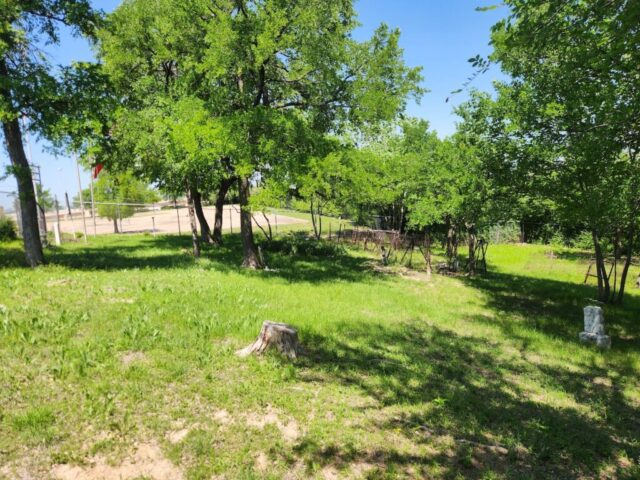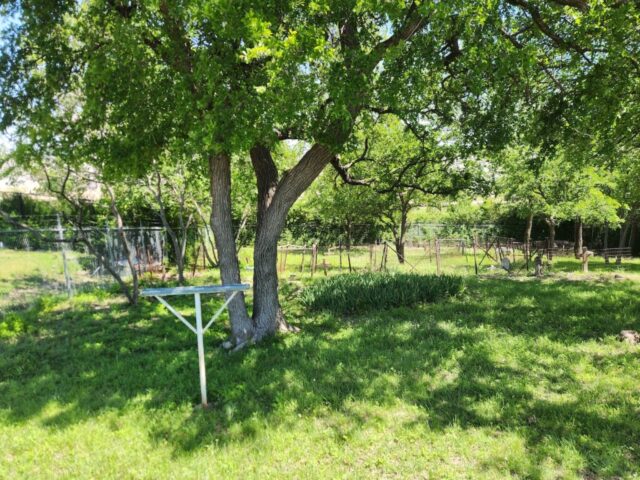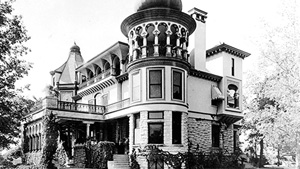
by Frances James
This small cemetery is located about six miles west of the Dallas County Courthouse surrounded by large warehouses and is in back of the telephone building on Communication, off of Cockrell Hill Road and I-30. The ample parking lot of the telephone company makes access easy – after you clear it with the guard. It has not always been easy to find. For many years the cemetery was stranded among the pits and the hills of the 900 acre site that had produced cement since 1907. Many of the workers at the cement plant were from Mexico and the company provided this land for a cemetery for them.
The Mexican Revolution in 1910 was killing one of every five men. These workers had heard there was opportunity for work in North Texas and to escape from the killing during the Mexican Revolution, crossed the border and received a green card and walked from Laredo to Dallas to work. The history for this site was provided by workers and their descendants as no records for the cemetery were kept. They were friends and relatives since many came from the Guanajuato area of Mexico. Many of the head stones on the graves in the small cemetery are made from cement with names scratched in Spanish. A few head stones have been replaced; one is a government issued stone for Eladio Martinez. Eladio was killed in the Philippines in 1945. Martinez received a Purple Heart and was first buried in Santa Barbara south of the summer capitol of the Philippines and was re-interred in this small cemetery in the 1950s. Eladio’s father worked for fifty years for the cement company and retired with a small pension. Eladio’s mother, also from Mexico was afraid of lightning and had a special ritual she performed on the small porch of the house. She never did learn English and her death certificate showed starvation.
Another family has a son buried here who was shot and killed by a nearby landowner when the young man was picking pecans on his land. The landowner took the body in to the sheriff by putting it across his horse. He told the law officer that the Mexican had shot at him and that he had killed him in self defense. The young Mexican man had never had a gun. The landowner was not prosecuted.
The Trinity Portland Cement Company also provided housing for the workers as public transportation to and from this remote site was inadequate. The frame houses erected for the workers provided only cold water and no heat. The housing rented for $2.00 per month per room! The last house was moved from this site in 1959.

July 4, 1929: The Portland Cement Company always stressed safety and, if there were no accidents during the year, the Company provided for a Holiday barbeque on the 4th of July. In 1929 a large picture of the men and their families was made. The background shows the houses in the village where they lived and the families were all posed in the large field where they had gathered to play baseball.
The workers themselves built a small school on Chalk Hill Road for their children. This was a county elementary school. When students were ready for high school they attended Crozier Tech in Dallas and rode a Jitney type bus into town. More recently this small building, abandoned as an elementary school, has been used for various types of businesses.
Land in this area was first occupied by La Reunion Colonist in 1850s. After the colony disbanded in 1858, some of these Europeans went back to Europe, but others stayed in Dallas County. These special limestone quarries were used to manufacture bricks and special clay was used to develop Terra Cotta and fire proof bricks. Texaco Company had a tank farm in this vicinity and both the Horton family home and cemetery are nearby.
A settlement had quickly grown in 1873 when the Missouri Kansas and Texas Railroad to Ft Worth was forced to stop building due to the lack of funds. The community, which developed at this dead end next to the Trinity River, was named Eagle Ford. The name was selected as nests of eagles were found near the ferry that crossed the Trinity in this vicinity.
John Horton who owned a large amount of land in Dallas County donated land for the railway right-of-way and the town did have a depot. Eagle Ford once had a population of nearly 3000. It had a hotel, a grocery store, and a reputation of being the end of the line! The railroad soon amassed enough funds to build a bridge over the Trinity River. The people who lived farther west of the Trinity realized how advantageous it would be to have a railroad. The farmers and ranchers themselves helped to complete the laying of the tracks to Fort Worth. The wives would arrive at lunch time with food so the men could keep working.
The name of Southwestern States Portland Cement Copany was changed in 1915 to Trinity Portland Cement Company. In 1972 the name was again changed to General Portland Inc. when it was purchased by the La Farge Company from France. By the 1980s the entire operation was closed and all equipment and buildings were moved or demolished. The hundreds of acres of pocked marked pits sat vacant for several years. From time to time some entrepreneur would announce his plans for the site, but none of these big plans were ever completed, until late in the 1980s when much of the vacant land was developed for warehouses. It is now called Pinnacle Park.
Southwestern Bell Telephone Company built a new facility near Cockrell Hill Road and I-30. Paved access roads were constructed. Infra-structure was provided and the long abused, useless land is now a bustling complex.
This small cemetery, sitting on the slope of a hill with a fence around it is now easily accessible. It was neglected during these years as the only access was walking on the uneven ground. Now, adjacent to the telephone company parking lot, it is safe and available for the families of those pioneer families to again visit when they choose.
This western side of Dallas County has seen many changes in the last few years, but the small cemetery remains within its fenced-in area to tell the story of these workers who came to the United States seeking a better life.
Frances James, “Dallas County History – From the Ground Up, Book I,” 2007.





